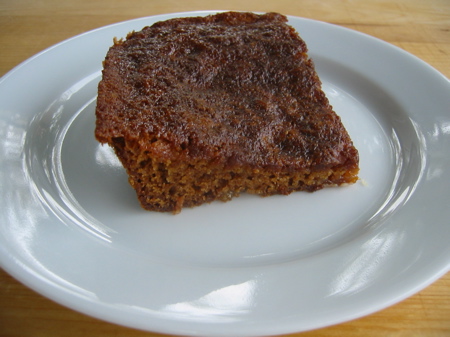Call it a “Unique Fixer-Upper Opportunity”

Well, here’s how my first attempt at Woodford pudding turned out. A fallen, sticky brown cake-like object. Good though. Or at least the wife liked it. She said that with all the jam flavor, cinnamon and nutmeg, it tasted “like fall”. To me it was a bit of a blast from the past, since I remember some old family cake recipes tasting this way: very sweet, dark and crumbly with plenty of spice.
So why did this pudding, er…cake, er…thing fall? On the one hand it could be that I baked it at too high a temperature, causing it to rise fast then fall before the interior had set. However the oven (in absence of a direction in the recipe) was set to 325. Not much, even for a “pudding”. Then again it could be because I jiggled it a bit testing for doneness, which I did after it had been in the oven for about 30 minutes. Though there again a pudding isn’t a soufflé, it shouldn’t be terribly delicate. So what happened then?
For a better idea of why my pudding fell, it might pay to look at the ingredient list. For as I’ve written extensively before, cakes and muffins have two basic forces operating in them: “up” forces and “down” forces. The “up” forces are created by the things that leaven and contribute to structure, in this case things like baking soda, flour and eggs. The “down” forces are all those things that put a drag on that upward momentum and structure, things like sugar, jam, sour cream and butter. Looking at this recipe, there is a paltry 5.5 ounces of flour and teaspoon of soda to lift and hold 7 ounces of sugar, 8 ounces of butter, 8.5 ounces of sour cream and 13.5 ounces of jam. What about the eggs? you may be asking. Aren’t they helping? Well, ordinarily they would be, but in this case the recipe calls for separating out the whites for later use as a meringue topping (which I didn’t do to try to simplify things). Since whites are where the muscle is when it comes to building structure (yolks mostly add richness and color), here the eggs actually belong in the “down” foces column.
Now I’m not claiming that there wasn’t operator error involved here. I could only guess at the heat level and baking time (the slight jiggle probably didn’t help either). Yet it seems to me that keeping this pudding inflated was a long shot at best. Maybe, just maybe it would have stayed up if the egg whites were included. Which is the first thing I’m going to to try when I make it again sometime over the next few days. Of course I’m tempted to make other alterations as well, but then in these types of R & D cases it’s generally better to only change one thing at a time.
Oh, and why is the pudding so dark without there being any brown sugar or molasses in the recipe? Well may you ask. It’s because of all the sugar brought to the party by the jam. It turns to caramel in the oven, thus turning the pudding brown. It also gets tooth-stickingly gooey, something I really didn’t like about this recipe either. That’ll have to change too, but first things first.